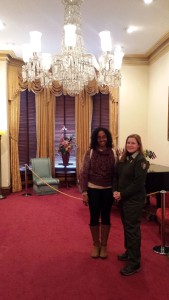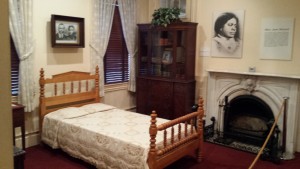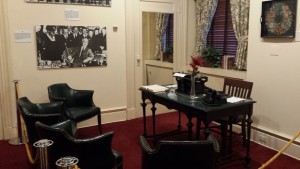Mary McLeod Bethune National Historic Site
Washington, District of Columbia (Free)
February 15, 2015
This was my second visit to the National Park Service’s Mary McLeod Bethune Historic Site, former headquarters of the National Council of Negro Women (NCNW) and residence of Bethune. We’d visited back in 2010, but after touring Bethune’s home in Daytona Beach and as a contribution to this project, I was eager to return.
The site is a Brownstone in Logan Circle, a neighborhood where many members of DC’s African-American elite had made their homes. In fact, Carter G. Woodson’s home was nearby, and our ranger tour guide, Rosemary, was apologetic that Woodson’s home was being restored by the Park Service but will not open until 2016. The Mary McLeod Bethune Site was temporarily housing some artifacts from Woodson’s home.
We entered the parlor of the home, and Rosemary pointed out the original chairs and chandelier, along with the piano, and some photographs on the walls. The chandelier is allegedly a hand-me-down from the Truman Whitehouse. When Bethune heard President Harry Truman was in the process of remodeling, she asked him for it. While the piano is not the original, it sits in the spot of the original piano, and it is decorated with flags from around the world just as the piano was in Bethune’s time. Rosemary told us how the NCNW considered itself an international organization, and one photograph on display shows the NCNW leaders at their conference table with a delegation of Japanese women. On display are also photographs of subsequent NCNW presidents, Dorothy Ferebee, Vivian Carter Mason, and Dorothy Height.
On the second floor of the home is Bethune’s bedroom.  There, Rosemary explained that the home had three bedrooms on the third floor that had been available to traveling African-American women who needed accommodations since accommodations were not readily available to African-American travelers during Bethune’s time. Hanging in Bethune’s room are photographs from her early life including a portrait of her parents, a photograph of Booker T. Washington, a photograph of the Negro School for Girls in its early days, and a photograph of young Bethune.
There, Rosemary explained that the home had three bedrooms on the third floor that had been available to traveling African-American women who needed accommodations since accommodations were not readily available to African-American travelers during Bethune’s time. Hanging in Bethune’s room are photographs from her early life including a portrait of her parents, a photograph of Booker T. Washington, a photograph of the Negro School for Girls in its early days, and a photograph of young Bethune.
 Bethune’s office next door still contains the original office furniture, and on display are photos from Bethune’s political life, like one of her in a large group with President Franklin Roosevelt. Rosemary also took us into the conferenceroom that still houses the original wooden conference table and chairs. In that room was also an exhibit, “Bethune Goes to Hollywood,” highlighting Bethune’s relationship with entertainers like Marian Anderson and Hattie McDaniel.
Bethune’s office next door still contains the original office furniture, and on display are photos from Bethune’s political life, like one of her in a large group with President Franklin Roosevelt. Rosemary also took us into the conferenceroom that still houses the original wooden conference table and chairs. In that room was also an exhibit, “Bethune Goes to Hollywood,” highlighting Bethune’s relationship with entertainers like Marian Anderson and Hattie McDaniel.
One thing that stood out about this tour was how Rosemary emphasized, just as we’d heard in Bethune’s Daytona Beach home, Bethune’s gift for fundraising. She was not afraid to make powerful requests of people with the resources she needed. In this case, Bethune raised funds for the NCNW and other organizations. She knew how to make giving beneficial for others, and she used those gifts to improve the lives of African-Americans and women around the country. Even the purchase of this home for the NCNW was partly made possible by a $10,000 donation by Marshall Field, heir and namesake of 19th century department store mogul.
As a last stop on our tour, we sat in the visitors’ center and listened to a 1955 audio recording of the last speech Bethune gave at the Twentieth Anniversary Brotherhood Luncheon where she was being honored, the audio footage of which was only recently discovered. In that speech she foreshadows her death, only two months later, and addresses women around the world asking them to “take the torch that was placed in our hands possibly twenty years ago, and carry that torch higher and higher and higher, until the spirit of brotherhood shall have enveloped the world, and mankind everywhere will understand the change of heart and mind.” She goes on to advocate for peace and fellowship and love.
Bethune’s legacy lives on as the NCNW continues its work on improving the lives of women of color on issues including healthcare and education. I have no doubt that Bethune would be proud, and on my next visit to DC, I hope to continue my exploration of Bethune and her legacy by paying a visit to the current headquarters of the only African American organization to have occupied prime real estate on Pennsylvania Avenue for nearly twenty years.
Check back next Monday, May 11 to read my first of two posts about the National Great Blacks in Wax Museum of Baltimore, Maryland.
